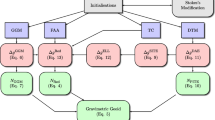Abstract
Determination of the gravimetric geoid is based on inversion of observed values of gravity into the disturbing gravity potential, i.e., the unknown potential is sought from discrete values of its vertical gradient. This transformation is often solved using boundary-value problems of the potential theory defined in terms of the Laplace differential equation and corresponding boundary conditions. However, this apparatus requires the potential function to be harmonic everywhere outside the boundary on which the unknown potential is solved for. For geoid determination, the boundary represents the geoid that is usually approximated for derivation of the solution by a geocentric sphere or reference ellipsoid. Since there are topographical and atmospheric masses outside the geoid, the potential function is not harmonic everywhere outside the geoid and the so-called reduction of the gravity potential and its functionals must be applied. This manuscript investigates the generalized method of Helmert’s condensation, namely its numerical implications for the standard procedure of geoid determination. An optimum location of the condensation layer is investigated from the point of relative smoothness of the gravity field and numerical difficulties with gravity inversion. The test area in the Canadian Rocky Mountains with a highly variable gravity field and topography is used for numerical investigations. Numerical results indicate that the condensation layer buried approximately 20–30 km inside the geoid gives the best results in terms of the gravity field smoothness as well as the complexity of gravity inversion. However, larger values of the primary indirect effect on the geoid for this depth of the condensed masses seem to overcome these numerical advantages.
Similar content being viewed by others
References
Bayoud F A 2001: Some investigations on local geoid determination from airborne gravity data. UCGE Reports 21054, Department of Geomatics Engineering, The University of Calgary
Bruns H 1878: Publikation des Königlichen Preussischen Geodätischen Institutes, Berlin
Gradshteyn I S, Ryzhik I M 1980: Tables of integrals, series, and products. Academic Press, New York
Heiskanen W A, Moritz H 1967: Physical geodesy. Freeman and Co., San Francisco
Heck B 1993: A revision of Helmert’s second method of condensation in the geoid and quasigeoid determination. Presented at 7th IAG Symposium “eodesy and Physics of the Earth”, No. 112, Potsdam, 1992
Heck B 2003: Journal of Geodesy, 77.
Helmert F R 1884: Die mathematische und physikalische Theorien der höheren Geodäsie. B G Taubner, Leipzig
Martinec Z 1998: Boundary-value problems for gravimetric determination of a precise geoid. Lecture notes in earth sciences, 73, Springer
Novák P 2003: Journal of Geodesy, 77, 193–206.
Novák P, Grafarend E W 2005: Journal of Geodesy, 78, 691–706.
Vaníček P, Huang J, Novák P, Pagiatakis S, Véronneau M, Martinec Z, Featherstone W E 1999: Journal of Geodesy, 73, 180–192.
Vaníček P, Novák P, Martinec Z 2001: Journal of Geodesy, 75, 210–215.
Author information
Authors and Affiliations
Corresponding author
Rights and permissions
About this article
Cite this article
Novák, P. Gravity reduction using a general method of Helmert’S condensation. Acta Geod. Geoph. Hung 42, 83–105 (2007). https://doi.org/10.1556/AGeod.42.2007.1.5
Received:
Accepted:
Published:
Issue Date:
DOI: https://doi.org/10.1556/AGeod.42.2007.1.5




